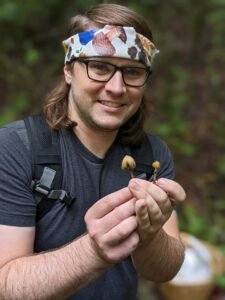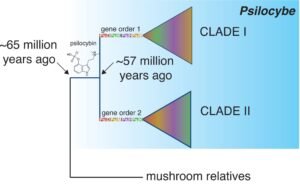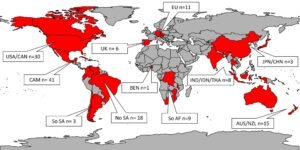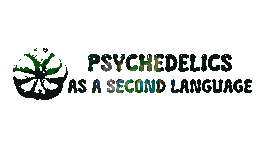Prehistoric psilocybin
Ethnobotanicals are the most antique forms of psychedelic consumption, but for how long have they been around? We have proof of human and animal ingestion around 3,000 years ago, but could species before have also presented the existence of such species?
The team recently completed the largest genomic diversity study for the genus Psilocybe, analyzing 52 specimens, including 39 species never sequenced before.
During genomic analysis, authors found that the psilocybe genus arose much earlier than thought. The genus was around 65 million years ago, around the dinosaur-killing asteroid that caused the mass extinction event. Psilocybin, however, was only synthesized in the genus with four to five possible horizontal gene transfers to other mushrooms from 40 to 9 million years ago.
Analysis revealed two distinct gene orders within the gene cluster responsible for psilocybin production. These two gene patterns correspond to an ancient split in the genus, suggesting two independent acquisitions of psilocybin in its evolutionary species. The study first reveals a strong evolutionary pattern within the gene sequences underpinning the psychoactive protein synthesis.

“If psilocybin does turn out to be this kind of wonder drug, there’s going to be a need to develop therapeutics to improve its efficacy. What if it already exists in nature?”
“There’s a wealth of diversity of these compounds out there. To understand where they are and how they’re made, we need to do this kind of molecular work to use biodiversity to our advantage.”
-Bryn Dentinger, curator of mycology at NHMU and senior author of the study
The analyzed specimens came from museum collections around the world. Twenty-three of the 52 specimens were the gold standard designating species against which all other samples were measured.

“These type specimens represent hundreds of years of thousands of scientists’ collective effort to document diversity, way before people were thinking about DNA.”
“That’s the beauty of it—no one has really sequenced type specimens at this scale, and now we get to produce molecular and genomic data to the gold standard of Psilocybe types for people to compare against.”
-Alexander Bradshaw, postdoctoral researcher at the U and lead author of the study
Previously, researchers identified the cluster of four core genes responsible for the production of psilocybin based on genomic analysis of three closely related Psilocybe species. All had matching gene patterns within the psilocybin-producing gene clusters. This study’s expanded genomics of 52 specimens revealed a second distinct pattern.
Finding 17 specimens had the original order. Meanwhile, 35 exhibited the new pattern.
“We’ve shown here that there’s been a lot of change in gene order over time, and that provides some new tools for biotechnology. If you’re looking for a way to express the genes to produce psilocybin and related compounds, you no longer have to rely on only one set of gene sequences to do that. Now there’s tremendous diversity that scientists can look at for lots of different properties or efficiencies,”
-Dentinger, associate professor of biology at the University of Utah.
The new pattern presented that there was an ancient split of the two gene clusters that occurred around 57 million years ago. Such information also corresponded to a shift in the ecology. The first psilocybin-producing mushrooms likely arose as wood-decomposing fungi, then transitioned to the soil after splitting, with some species transiting to growing on herbivore dung. Such ecological shift to dung appears to have occurred at least twice independently in their evolutionary history.

So, what does this mean for psilocybin mushrooms?
These new findings will allow future research to clarify the most basic question.
What does psilocybin do for mushrooms?
The newly found gene clusters will likely lead to more information regarding the question. However, as far as now, it is inconclusive to know what this information will reveal.
One of the most shared theories between scientists is that these fungi started producing these compounds as a method of defense from insects and arachnids, as they are affected by psilocybin (however, empirical studies are lacking, and other authors have confirmed that psilocybin-containing mushrooms regularly host healthy, thriving insect larvae). Some have proposed that this altered mental state might be a deterrent to predation, the possibility that psilocybin functions as a laxative or induces vomiting to spread spores before they are fully digested. However, the scarcity of these fungi growing in the wild makes it less likely that animals could learn to recognize them.
Thus, researchers at the University of Utah and the Natural History Museum of Utah are preparing to experiment with a test theory designed as the Gastropod Hypothesis.
The theory connects the timing and divergence of Psilocybe coinciding with the KPg boundary, the geological marker of the asteroid that threw Earth into a brutal, prolonged winter that killed 80% of all life. Two lifeforms that thrived during darkness and decay were fungi and gastropods. Evidence shows that gastropods had a massive diversification and proliferation after the asteroid hit, and we know that terrestrial slugs are predators of fungi. With the study dating Psilocybe existence to around 65 million years, there is an hypothesis that Psilocybe mushrooms might have started producing psilocybin as a slug deterrent. They hope that their feeding experiments will shed some light on their hypothesis.
In 2020, the authors set a goal to get a genome sequence for every Psilocybe type specimen. Today, researchers generated 71 types of specimens and continue to collaborate with collections worldwide.

“It’s impossible to overstate the importance of collections for doing studies like this. We are standing on the shoulders of giants who spent thousands of people-power hours to create these collections so that I can write an email and request access to rare specimens, many of which have only ever been collected once and may never be collected again.”
-Alexander Bradshaw.
Learn more about the Psilocybe genus and Psilocybin here!

